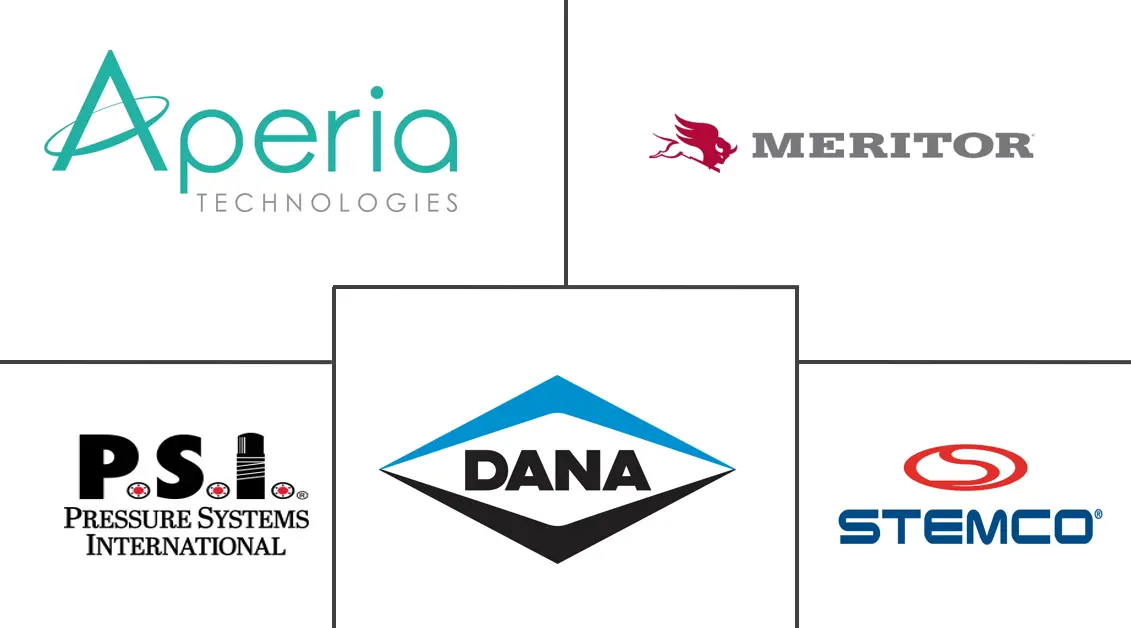Automotive Automatic Tire Inflation System Market Size and Share
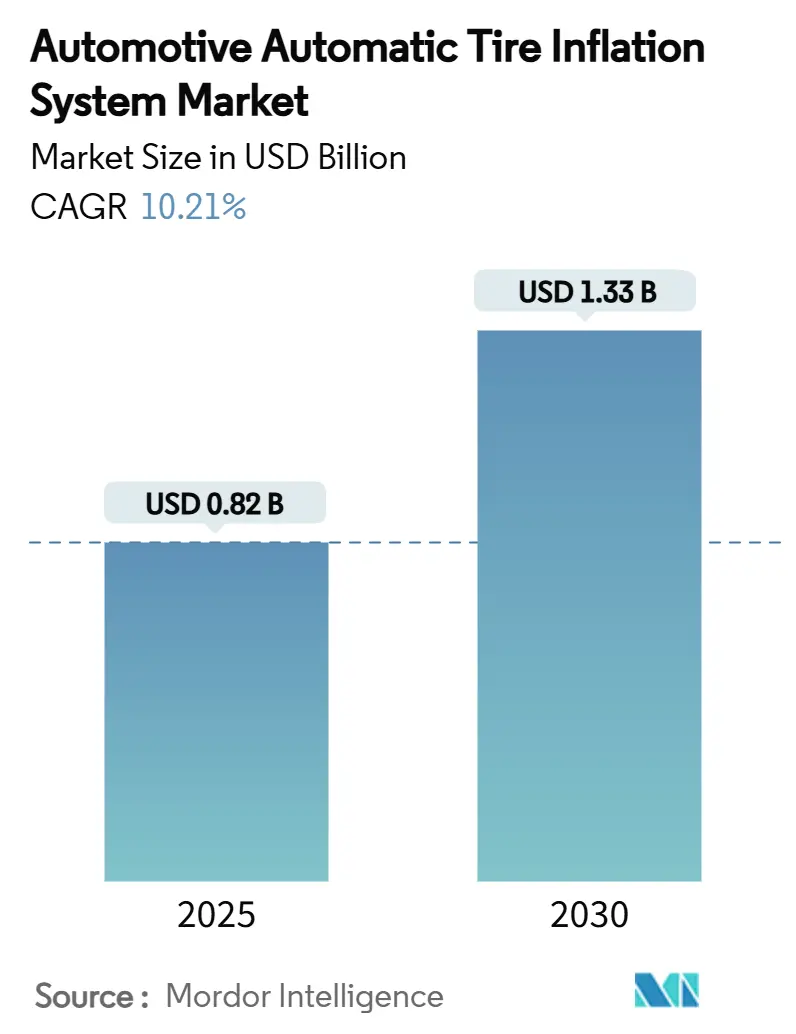
Automotive Automatic Tire Inflation System Market Analysis by Mordor Intelligence
The automotive automatic tire inflation system market size registers a valuation of USD 0.82 billion in 2025 and is forecast to reach USD 1.33 billion by 2030, advancing at a 10.21% CAGR. Growth reflects coordinated safety regulations, fleet cost-reduction imperatives, and tighter integration with connected-vehicle architectures. North American fleets must comply with 49 CFR 393.75 cold-inflation rules, while the European Union’s General Safety Regulation II requires tire-pressure monitoring across all new vehicles, indirectly cementing demand for fully automatic inflation capabilities. Commercial fleets realize up to 1.4% fuel savings when tires remain at correct pressure, sharpening return on investment for automatic systems [1] “Tire Pressure Best Practices, ” North American Council for Freight Efficiency, nacfe.org. In parallel, agricultural and construction equipment makers embed central pressure control to meet soil-conservation mandates and precision-farming needs, as seen in Fendt’s VarioGrip that varies pressure from 8.7 to 36.3 PSI while in motion. Investment momentum is buoyed by venture funding, illustrated by Aperia Technologies’ USD 45 million raise that targets hub-mounted self-powered inflators.
Key Report Takeaways
- By vehicle type, medium and heavy commercial vehicles led the automotive automatic tire inflation system market with a 66.82% revenue share in 2024; off-highway vehicles are projected to expand at an 11.84% CAGR through 2030.
- By application, on-road tires accounted for 72.41% of the automotive automatic tire inflation system market size in 2024, while off-road tires are advancing at a 12.29% CAGR to 2030.
- By sales channel, the OEM segment held 58.33% of the automotive automatic tire inflation system market share in 2024; the aftermarket channel records the highest projected CAGR at 11.57% through 2030.
- By product type, central tire inflation systems led the automotive automatic tire inflation system market, capturing 62.15% revenue share in 2024; self-powered hub inflators are forecast to grow at a 12.91% CAGR.
- By geography, North America dominated the automotive automatic tire inflation system market with 39.81% share in 2024, while Asia-Pacific is forecast to grow at a 12.19% CAGR.
Global Automotive Automatic Tire Inflation System Market Trends and Insights
Drivers Impact Analysis
| Driver | (~) % Impact on CAGR Forecast | Geographic Relevance | Impact Timeline |
|---|---|---|---|
| Fleet Focus on Fuel and Tire-Wear Cost Reduction | +2.8% | Global, strongest in North America and Europe | Medium term (2–4 years) |
| Stringent Tire-Safety Regulations | +2.1% | Global, early uptake in North America and EU | Short term (≤ 2 years) |
| Expanding Commercial-Vehicle Parc and Freight Activity | +1.9% | Asia-Pacific core, spill-over to MEA | Medium term (2–4 years) |
| OEM Integration with TPMS and Connected Platforms | +1.7% | Global, led by North America and Europe | Long term (≥ 4 years) |
| Autonomous-Trucking Demand for Predictive Tire Health | +1.2% | North America and EU, pilot programs in APAC | Long term (≥ 4 years) |
| Agricultural Shift to On-the-Go Soil-Conserving Pressure Control | +0.6% | Global, concentrated in agricultural regions | Medium term (2–4 years) |
| Source: Mordor Intelligence | |||
Rising Fleet Focus on Fuel and Tire-Wear Cost Reduction
Tire expenditures represent 15–20% of heavy-truck operating budgets, and under-inflation generates up to 95% of roadside tire failures. Pressure Systems International quantifies 1.4% mean fuel gains and 10% tire-life extension when automatic inflation is installed [2]” Cummins Inc., “Automatic Inflation Efficiency Study, cummins.com. Data-rich platforms deliver live pressure, temperature, and load information, letting dispatchers optimize speed profiles and maintenance windows. Long-haul carriers accrue the greatest absolute benefit because incremental savings compound across annual mileages that exceed 120,000 miles per tractor. Consequently, procurement teams embed total cost-of-ownership models that prioritize automatic inflation during tractor and trailer replacement cycles.
Stringent Global Tire-Safety Regulations
Worldwide statutes are elevating tire-maintenance discipline. The EU General Safety Regulation II, effective July 2024, mandates tire-pressure monitoring on every newly homologated vehicle category except M1, creating a universal baseline that encourages automatic inflation upgrades. Complementary Euro 7 rules set tire-abrasion caps with 2032 compliance deadlines [3] “Euro 7 Proposal Briefing, ” International Council on Clean Transportation, theicct.org. In the United States, Federal Motor Carrier Safety Administration inspectors enforce cold-inflation minimums during roadside checks, prompting large fleets to deploy automated systems to avoid citations. Similar provisions are cascading into South America and Southeast Asia as export-oriented OEMs harmonize with EU standards. As a result, fleet managers perceive automotive automatic tire inflation system market adoption as a compliance necessity that also unlocks operational savings.
Expanding Commercial-Vehicle Parc and Freight Activity
Asia-Pacific truck registrations continue to climb with e-commerce and infrastructure outlays. Heavy-duty fleets in India seek efficiency tools to curb fuel use that drives 12% of national energy-related CO₂ emissions. Regional OEMs now bundle integrated tire management with connected dashboards on battery-electric and gas-powered rigs, mindful that rolling resistance erodes driving range. Governments incentivize adoption through green-freight programs that score fleets on energy intensity, effectively nudging operators toward automotive automatic tire inflation system market solutions.
OEM Integration with Advanced TPMS and Connected Platforms
Manufacturers move beyond standalone modules toward holistic tire intelligence. Continental’s ContiConnect stitches pressure and temperature data into drive-line diagnostics, enabling predictive alerts that slot into existing telematics workflows. TDK partners with Goodyear to embed multi-axis MEMS sensors inside tire cavities, widening datasets for load estimation and tread-wear analytics. Integrated architectures raise switching costs for fleets and sideline niche vendors that lack deep software stacks. Over the long term, converged platforms will dominate the automotive automatic tire inflation system market as autonomy features rely on continuous tire-health assurance.
Restraints Impact Analysis
| Restraint | (~) % Impact on CAGR Forecast | Geographic Relevance | Impact Timeline |
|---|---|---|---|
| High Upfront Cost and Integration Complexity | -1.8% | Global, sharper in emerging economies | Short term (≤ 2 years) |
| Reliability and Maintenance Issues in Harsh Duty Cycles | -1.2% | Global, intense in off-highway segments | Medium term (2–4 years) |
| Limited Global Aftermarket Service Ecosystem | -0.9% | Global, acute in emerging markets and rural areas | Medium term (2–4 years) |
| Cyber-Security Vulnerabilities in Connected ATIS | -0.7% | Global, concentrated in connected vehicle applications | Long term (≥ 4 years) |
| Source: Mordor Intelligence | |||
High Upfront Cost and Integration Complexity
System packages range from USD 1,500 to USD 5,000 per vehicle. Retrofit projects add labor hours and potential downtime that many small carriers cannot absorb. Commercial tire dealers note budget-constrained operators delaying upgrades until capex cycles align, even though break-even analysis often shows payback inside 18 months. Training technicians, calibrating sensors, and harmonizing software with legacy electronic control units further slow adoption in price-sensitive regions.
Reliability and Maintenance Issues in Harsh Duty Cycles
Mining, forestry, and military vehicles face vibration, debris, and temperature swings that stress valves, compressors, and harnesses. Field reports show a higher failure rate compared to on-road tractors, leading to unplanned downtime and increased spare parts costs. Remote project sites lack specialized service centers, forcing fleet managers to keep inventory and train staff on-site, which reduces the total cost benefits offered by the automotive automatic tire inflation system industry. Vendors that ruggedize components and simplify service routines will gain market share in these demanding sectors.
Segment Analysis
By Vehicle Type: Commercial Dominance Drives Market Evolution
Medium and heavy commercial vehicles accounted for 66.82% of the automotive automatic tire inflation system market revenue in 2024, underscoring the sector’s outsized influence on the automotive automatic tire inflation system market. Elevated annual mileage, multi-axle configurations, and fuel-spend sensitivity combine to produce compelling investment cases for automatic inflation. Remote diagnostics and over-the-air pressure calibration let dispatchers minimize roadside service calls and preserve delivery schedules. Adoption is now filtering into regional haul and final-mile trucks as OEMs standardize inflation ports and data protocols across model lines.
Off-highway equipment exhibits the sharpest trajectory at an 11.84% CAGR through 2030. Precision agriculture mandates gentle soil loading to protect yield, while construction and military vehicles require fast adjustments between asphalt, gravel, and mud. Fendt’s in-cab VarioGrip toggles pressure inside seconds, boosting tractive efficiency and cutting compaction, and similar offerings from John Deere and CNH Industrial signal an industry shift toward embedded pressure control. Light commercial vans and passenger cars participate more modestly, yet EU safety rules and consumer preference for advanced driver-assistance features are nudging OEMs to incorporate scaled-down automatic inflation modules.
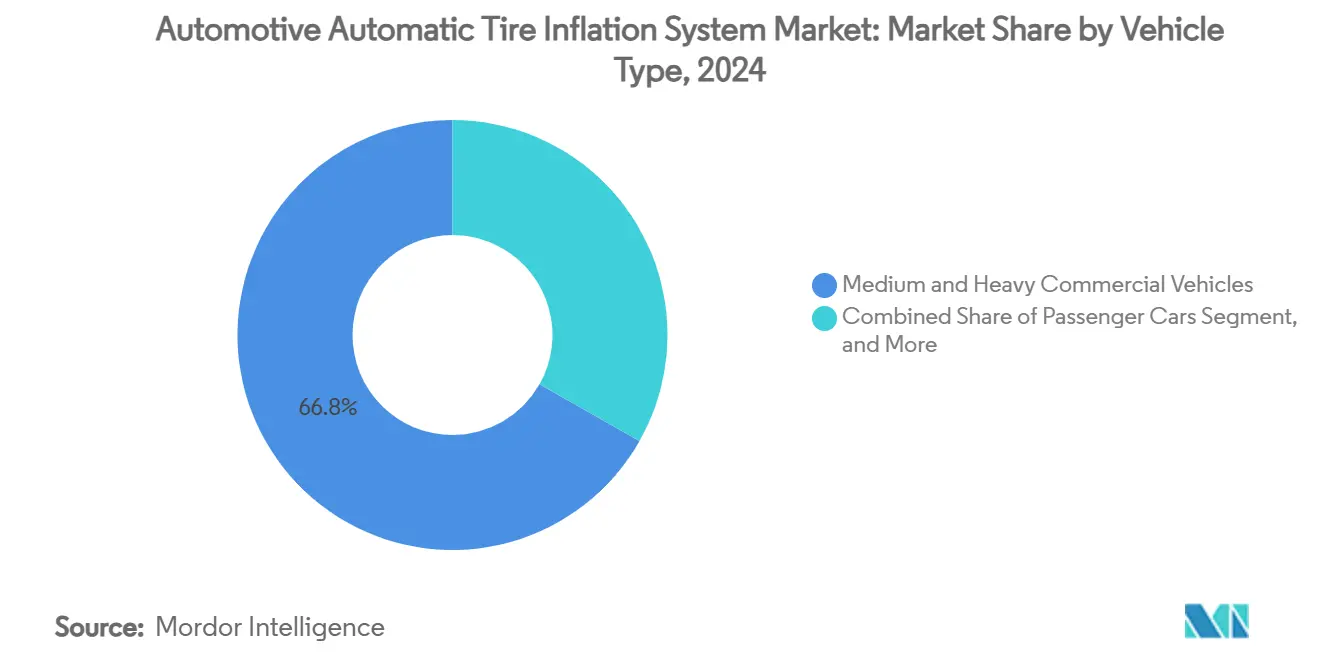
Note: Segment shares of all individual segments available upon report purchase
By Application: On-Road Dominance with Off-Road Growth Acceleration
On-road tires secured 72.41% of the automotive automatic tire inflation system market revenue in 2024, anchored by cross-continental trucking, where under-inflation steals fuel economy on every highway mile. Automated systems continuously regulate cold-inflation levels regardless of ambient swings that might lead to chronic under-pressure in conventional weekly-check routines. Fleet telematics dashboards integrate pressure KPIs alongside hours-of-service readouts, and managers benchmark depots on compliance percentages that correlate directly with diesel spend.
Off-road tires are climbing at a 12.29% CAGR, reflecting investment in smart machinery for quarrying, forestry, and agriculture. Michelin’s central system posts up to 4% productivity lifts and 10% fuel savings by tailoring pressure to soil type. Studies show that correct pressure can trim soil compaction depth by one-third, preserving arable land and reducing tillage energy. Similarly, wheel-loader operators report lower tire-related downtime after installing closed-loop inflation that alerts them before sidewall pinch damage occurs. These benefits cement future demand even as upfront pricing remains a barrier for smaller contractors.
By Sales Channel: OEM Integration Shifts Market Dynamics
The OEM pathway captured 58.33% revenue of the automotive automatic tire inflation system market in 2024, illustrating how automatic inflation is becoming an integral chassis subsystem. Heavy-duty brands such as Daimler Truck and Volvo Group bundle inflation kits on premium trim levels, and trailer manufacturers follow suit to differentiate equipment in a saturated leasing market. OEM integration ensures wiring harnesses and electronic control units are factory-matched, reducing warranty disputes.
Aftermarket uptake, growing at 11.57% CAGR, addresses the immense installed base of tractors and trailers already on the road. Independent service dealers broaden portfolios to include inflation installation, calibration, and telematics configuration. The automotive automatic tire inflation system market size for retrofit kits benefits from modular hub designs that require no compressor plumbing, shrinking installation windows. However, retrofit complexity still rises on vehicles older than 10 years that lack CAN bus gateways, compelling distributors to offer bundled hardware-plus-installation financing to accelerate close rates.
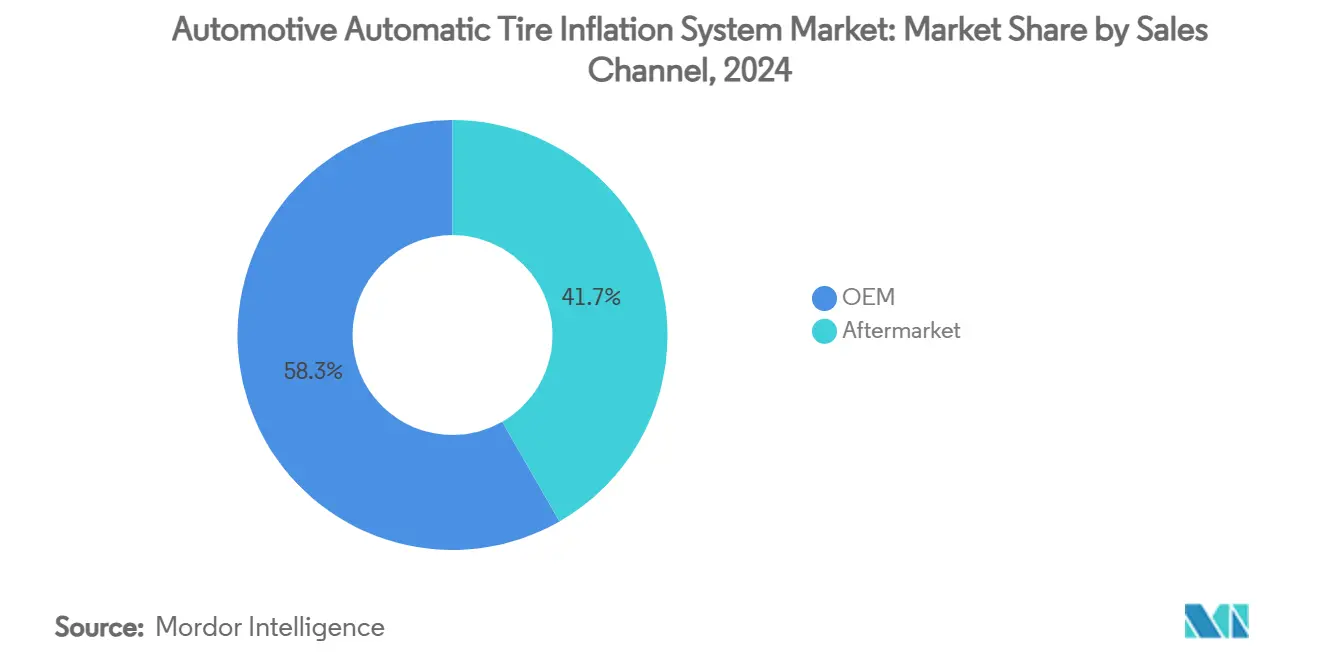
By Product Type: Center Tire Inflation System (CTIS) Leadership with Hub-Inflator Innovation
Central tire inflation systems held 62.15% revenue share of the automotive automatic tire inflation system market in 2024 because they deliver full-vehicle coverage and integrate easily with onboard air lines. Multi-channel controllers manage steer, drive, and trailer axles concurrently, supplying balanced pressure that curbs irregular wear patterns and enhances braking stability.
Self-powered hub inflators register the fastest CAGR of 12.91%. Aperia’s Halo harvests wheel rotation to energize a miniature pump, eliminating airlines and reducing potential leak points. Continuous wheel-end inflators straddle the middle ground, appealing to fleets that desire simplicity without giving up per-wheel regulation. Product selection often hinges on fleet mix: tractors with frequent trailer swaps favor hub devices for ease of installation, while dedicated vocational trucks lean toward CTIS to accommodate wide operating-pressure bands.
Geography Analysis
North America secured 39.81% revenue of the automotive automatic tire inflation system market in 2024, buoyed by well-defined regulatory frameworks and mature telematics penetration. Federal enforcement of tire-pressure rules prompts carriers to adopt automatic solutions as insurance against roadside fines. Large for-hire fleets cite 1–3% diesel savings and 15–20% tire-life gains, outcomes that reinforce board-level sustainability pledges. The region also hosts expansive pilots for driverless freight corridors, and autonomous developers require redundant tire-health systems that remove the driver from the maintenance loop.
Asia-Pacific posts the quickest ascent at 12.19% CAGR through 2030. Explosive e-commerce shipping volumes, extensive highway build-outs, and the push for electrified powertrains sharpen the economic rationale for automatic inflation. India’s logistics overhaul seeks to trim the 12–14% GDP drain tied to freight costs, and correcting tire pressure is a visible lever. Chinese OEMs such as FAW and Sinotruk integrate inflation valves on new energy trucks to extend battery range, positioning the automotive automatic tire inflation system market as a standard efficiency measure.
Europe remains consistent, guided by Union-wide safety and environmental directives. Regulation II obliges TPMS on every new vehicle, and Euro 7 introduces abrasion limits that depend heavily on optimum pressure. Operators in Germany and France combine inflation data with carbon reporting to satisfy customer Scope 3 disclosure requests. The Middle East and Africa trail in overall penetration, yet oil-exporting economies funnel infrastructure funds into vocational fleet upgrades, which lifts baseline demand even if service-center density lags.
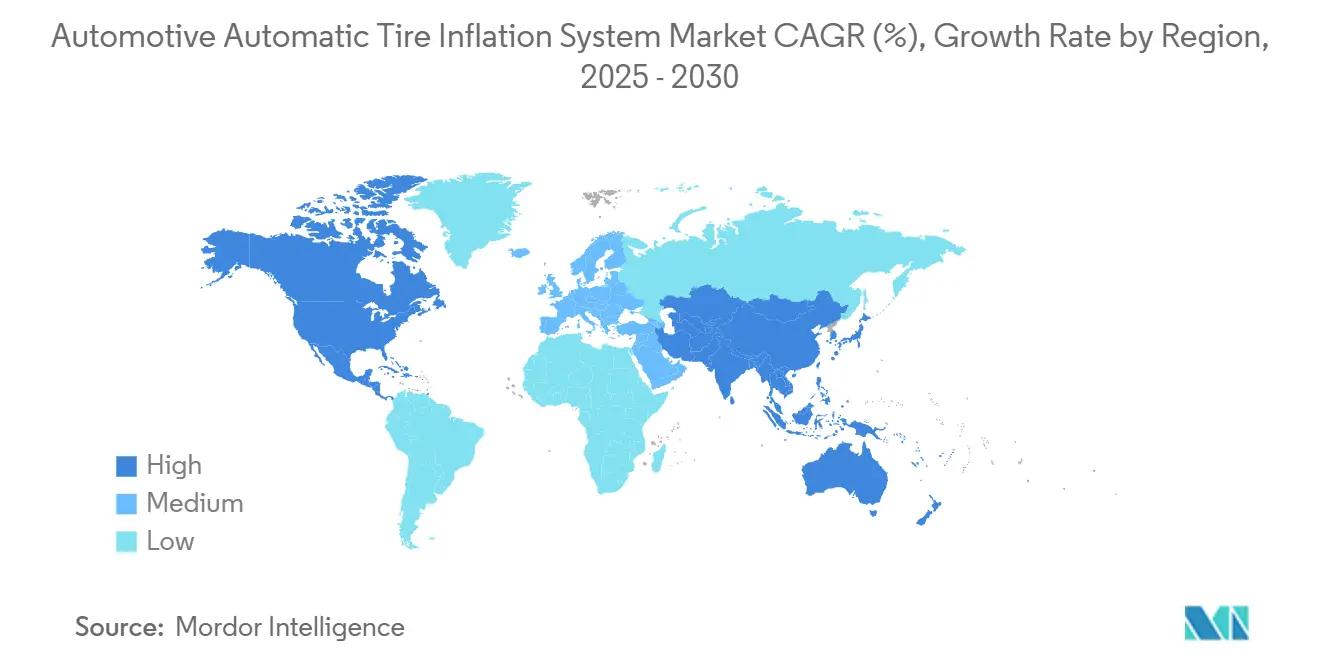
Competitive Landscape
The automotive automatic tire inflation system market features moderate fragmentation. Continental AG, Bridgestone Corporation, and Pressure Systems International leverage vertical integration, blending tires, sensors, and cloud analytics to secure lifecycle contracts with global fleets. Continental’s ContiConnect couples pressure and temperature inputs with predictive algorithms that issue maintenance work orders directly to depot systems.
Aperia Technologies occupies the innovation vanguard with its self-powered Halo platform, attracting USD 45 million in growth capital in 2023 to scale production. Hub-centric design sidesteps brake-chamber airlines, simplifying retrofits and positioning the firm as a preferred solution for trailer leasing companies that shun complex plumbing. Pressure Systems International partners with axle makers to factory-fit its systems, assuring OEM pull-through and a sizeable installed base ripe for software-upgrade subscriptions.
Cybersecurity emerges as a differentiation axis. Rutgers University demonstrated that inflated wireless packets can spoof legacy TPMS lacking cryptographic signatures. Vendors race to embed authenticated messaging and intrusion detection, reassuring fleet operators who manage mixed telematics stacks. Players that deliver end-to-end encrypted architectures without sacrificing battery life will gain procurement advantages, particularly among autonomous and high-value cargo haulers.
Automotive Automatic Tire Inflation System Industry Leaders
-
Aperia Technologies, Inc.
-
Meritor, Inc.
-
Pressure Systems International, Inc.
-
Dana Incorporated
-
STEMCO Products Inc.
- *Disclaimer: Major Players sorted in no particular order
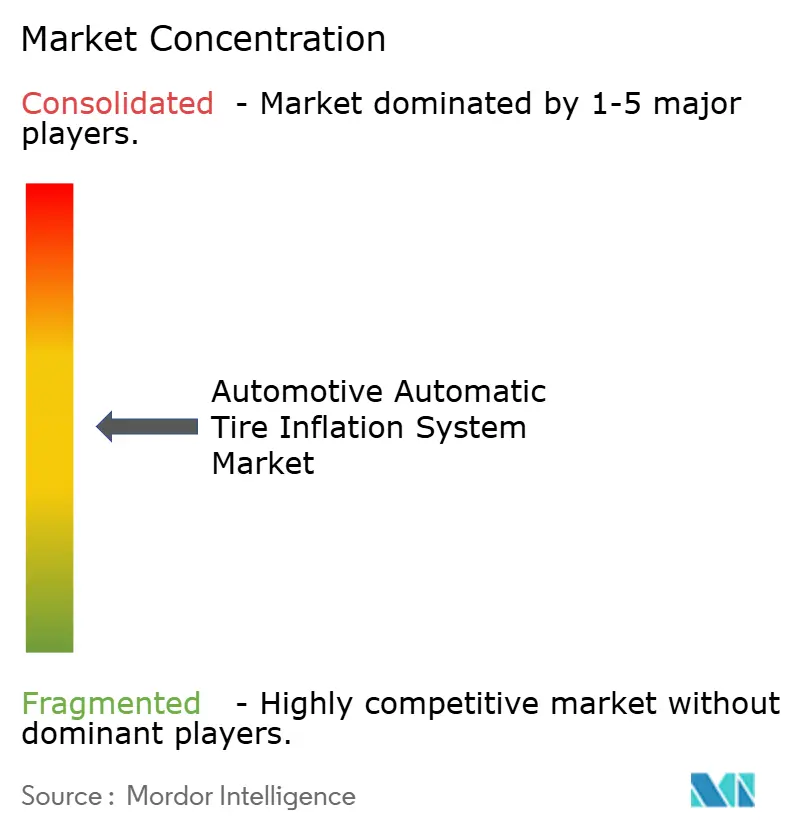


Recent Industry Developments
- April 2025: OTR joined forces with Pressure Systems International to embed TireView TPMS into OTR pneumatic assemblies, bringing real-time tire data to in-cab and smartphone displays.
- March 2025: Aperia Technologies partnered exclusively with Goodyear, melding Halo Connect i3 with Goodyear’s Tires-as-a-Service platform.
- August 2024: Freudenberg Sealing Technologies unveiled central tire inflation seals that self-adjust across terrains, cutting CO₂ emissions and boosting tire life.
- March 2024: Aperia Technologies launched Halo Connect i3, integrating remote pressure commands, configurable alerts, and wheel analytics for heavy-duty fleets.
Research Methodology Framework and Report Scope
Market Definitions and Key Coverage
Our study defines the automotive automatic tire inflation system (ATIS) market as revenue from factory-installed and retrofit units that actively monitor and correct tire pressure in passenger, commercial, and off-highway vehicles through central, wheel-end, or self-powered inflators sold via OEM and aftermarket channels worldwide.
Scope exclusion: stand-alone tire pressure monitoring sensors with no inflation function are not counted.
Segmentation Overview
- By Vehicle Type
- Passenger Cars
- Light Commercial Vehicles
- Medium and Heavy Commercial Vehicles
- Off-Highway Vehicles (Agricultural, Construction, Military)
- By Application
- On-the-Road Tires
- Off-the-Road Tires
- By Sales Channel
- OEM
- Aftermarket
- By Product Type
- Central Tire Inflation Systems (CTIS)
- Continuous/Wheel-End Inflators
- Self-Powered Hub Inflators
- By Geography
- North America
- United States
- Canada
- Rest of North America
- South America
- Brazil
- Argentina
- Rest of South America
- Europe
- Germany
- United Kingdom
- France
- Italy
- Russia
- Rest of Europe
- Asia-Pacific
- China
- Japan
- India
- South Korea
- Australia
- Rest of Asia-Pacific
- Middle East and Africa
- Saudi Arabia
- United Arab Emirates
- Turkey
- South Africa
- Nigeria
- Rest of Middle East and Africa
- North America
Detailed Research Methodology and Data Validation
Primary Research
Interviews with fleet managers, component engineers, aftermarket distributors, and safety regulators across North America, Europe, and Asia validated penetration ratios, retrofit appetite, and regional average selling prices, filling gaps left by open data.
Desk Research
We collated baseline vehicle production and parc statistics from OICA, NHTSA, Eurostat customs logs, and WSTS-style component trade codes, then layered insights from peer-reviewed SAE papers and fleet cost studies. Annual reports, 10-Ks, and investor decks of axle, hub, and compressor suppliers clarified pricing, while news feeds from Dow Jones Factiva tracked capacity shifts and regulatory milestones. The sources named are illustrative; many additional public references informed cross-checks and narrative shaping.
Market-Sizing & Forecasting
We start with a top-down rebuild of vehicle output and active fleet pools by class and region before applying ATIS factory-fit and retrofit penetration factors, which are then tested against selective supplier shipment roll-ups and channel checks. Key model inputs include commercial vehicle production, off-highway tractor sales, tire-inflation mandates, diesel price trends, telematics adoption rates, and ASP progression. A multivariate regression on these drivers produces the 2025-2030 forecast, while proxy ASP × volume estimates bridge sparse aftermarket data, especially in emerging markets.
Data Validation & Update Cycle
Outputs undergo dual-analyst review; variance dashboards flag deviations greater than five percent, and material events such as new legislation or large recalls trigger interim refreshes. Each study is revisited annually, with a final sweep just before delivery to ensure currency.
Why Mordor's Automotive Automatic Tire Inflation System Baseline Commands Reliability
Mordor places the 2025 market at USD 0.82 billion, while a leading global consultancy cites USD 0.78 billion for 2024 and an industry association values 2024 at USD 1.32 billion.
Divergence arises because studies differ on vehicle classes covered, inclusion of aftermarket sales, and price weighting; they refresh models on varying cadences.
Benchmark comparison
| Market Size | Anonymized source | Primary gap driver |
|---|---|---|
| USD 0.82 B (2025) | Mordor Intelligence | |
| USD 0.78 B (2024) | Global Consultancy A | Omits aftermarket retrofits and off-highway segments |
| USD 1.32 B (2024) | Industry Association B | Applies list ASPs and mixes monitoring sensors with inflators |
The comparison shows that Mordor's disciplined scope definition, dual-path validation, and yearly refresh deliver a balanced, transparent baseline that decision-makers can trace, question, and replicate with confidence.


Key Questions Answered in the Report
What is driving the strong CAGR in the automotive automatic tire inflation system market?
Stringent safety mandates in the United States and European Union, coupled with fleet demands for fuel and tire-wear savings, underpin the 10.21% CAGR.
Which vehicle class captures the largest share of global revenue?
Medium and heavy commercial trucks lead with 66.82% revenue because high mileage and multiple tire positions maximize cost-saving potential.
How big is the opportunity in off-highway equipment?
Off-highway vehicles post an 11.84% CAGR to 2030 as farming, mining, and defense operators adopt real-time pressure control for traction and soil protection.
Why are self-powered hub inflators growing faster than central systems?
Hub inflators avoid external airlines, shorten retrofit time, and suit high-volume trailer fleets, which explains their 12.91% forecast CAGR.
Page last updated on:
